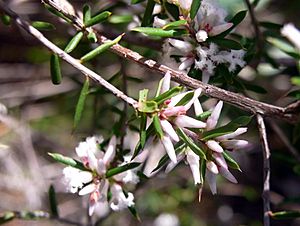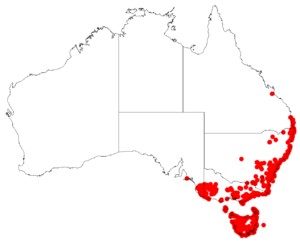Pink beard-heath facts for kids
Quick facts for kids Pink beard-heath |
|
|---|---|
 |
|
| St Ives North, Australia | |
| Scientific classification | |
| Genus: |
Leucopogon
|
| Species: |
ericoides
|
 |
|
| Occurrence data from AVH | |
| Synonyms | |
|
|
The pink beard-heath (scientific name: Leucopogon ericoides) is a common shrub. You can find it growing in southeastern Australia. It gets its name from its pretty pink or white flowers and its small, prickly leaves.
Contents
Discovering the Pink Beard-Heath
This plant first got a scientific name in 1793. It was called Styphelia ericoides by James Edward Smith. Later, in 1810, another scientist named Robert Brown gave it its current name, Leucopogon ericoides.
What Does It Look Like?
The pink beard-heath is a thin, prickly plant. It usually grows to be less than 0.9 meters (about 3 feet) tall. Its small branches have tiny hairs on them.
Leaves and Flowers
The leaves are long and narrow, like an oblong shape. They are about 4 to 15 millimeters long. Many plants in this group have leaves with straight lines, called parallel veins.
The flowers are either white or pink. They bloom in late winter and spring, from July to October. September is usually when you see the most flowers. The name ericoides means its leaves look like those of a European Heath plant.
Fruit
After the flowers, the plant grows small fruits. These fruits are often curved and shaped like an egg, but upside down. They have clear ridges and a flat top. When they are ripe, they turn brown and are about 2 to 5 millimeters long.
Where Does It Grow?
You can often find the pink beard-heath in dry eucalyptus woodlands and heathlands. It prefers to grow in sandy soils, especially sandstone areas.
Plant Neighbors
In the Sydney area, it often grows near other native trees. These include Sydney peppermint (Eucalyptus piperita), scribbly gum (E. sclerophylla), and narrow-leaved apple (Angophora bakeri).
Life Cycle and Survival
Pink beard-heath plants usually live between five and twenty years. When there is a bushfire, these plants are killed. However, they can grow back from seeds that are hidden in the soil. Bees love to visit the flowers to collect their sweet nectar.

